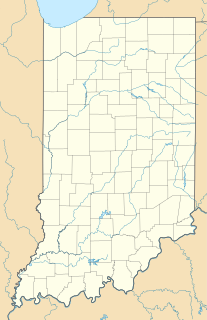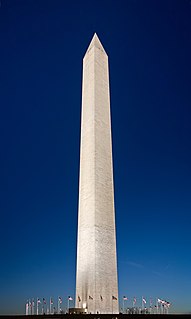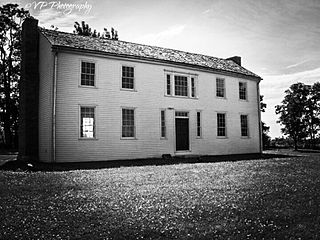
Hodgenville is a home rule-class city in LaRue County, Kentucky, United States. It is the seat of its county. Hodgenville sits along the North Fork of the Nolin River. The population was 3,206 at the 2010 census. It is included in the Elizabethtown metropolitan area.

Lincoln's New Salem State Historic Site is a reconstruction of the former village of New Salem in Menard County, Illinois, where Abraham Lincoln lived from 1831 to 1837. While in his twenties, the future U.S. President made his living in this village as a boatman, soldier in the Black Hawk War, general store owner, postmaster, surveyor, and rail splitter, and was first elected to the Illinois General Assembly.

Lincoln City is an unincorporated community in Carter Township, Spencer County in the southwestern part of the U.S. state of Indiana. It lies five minutes south of Interstate 64, northeast of Evansville, and approximately twenty miles north of the Ohio River.

Thomas Lincoln was an American farmer, carpenter, and father of the 16th President of the United States, Abraham Lincoln. Unlike some of his ancestors, Lincoln could not write. Lincoln struggled to make a successful living for his family and met challenges of Kentucky real estate border disputes, the early death of his first wife, and the integration of his second wife's family into his own family before making his final home in Illinois.

Nancy Hanks Lincoln was the mother of U.S. President Abraham Lincoln. Her marriage to Thomas Lincoln also produced a daughter, Sarah, and a son, Thomas Jr. When Nancy and Thomas had been married for just over 10 years, the family moved from Kentucky to Perry County, Indiana, in 1816. Nancy Lincoln died from milk sickness or consumption at the Little Pigeon Creek Community in Spencer County when Abraham was nine years old.

Abraham Lincoln Birthplace National Historical Park is a designated U.S. historic park preserving two separate farm sites in LaRue County, Kentucky, where Abraham Lincoln was born and lived early in his childhood. He was born at the Sinking Spring site south of Hodgenville and remained there until the family moved to the Knob Creek Farm northeast of Hodgenville when he was two years old, living there until he was seven years of age. The park's visitor center is located at the Sinking Spring site.
Mordecai Lincoln was an uncle of U.S. President Abraham Lincoln. He was the eldest son of Captain Abraham Lincoln, a brother of Thomas Lincoln and Mary Lincoln Crume, and the husband of Mary Mudd. Lincoln is buried at the Old Catholic or Lincoln Cemetery near Fountain Green, Illinois.

Lincoln Boyhood National Memorial is a United States Presidential Memorial, a National Historic Landmark District in present-day Lincoln City, Indiana. It preserves the farm site where Abraham Lincoln lived with his family from 1816 to 1830. During that time, he grew from a 7-year-old boy to a 21-year-old man. His mother, Nancy Hanks Lincoln, and at least 27 other settlers were buried here in the Pioneer Cemetery. His sister Sarah Lincoln Grigsby was buried in the nearby Little Pigeon Baptist Church cemetery, across the street at Lincoln State Park.

The presidential memorials in the United States honor the various Presidents of the United States and seek to perpetuate their legacies.

The Lincoln Log Cabin State Historic Site is an 86-acre (0.3 km²) history park located eight miles (13 km) south of Charleston, Illinois, U.S., near the town of Lerna. The centerpiece is a replica of the log cabin built and occupied by Thomas Lincoln, father of U.S. President Abraham Lincoln. Abraham Lincoln never lived here and only occasionally visited, but he provided financial help to the household and, after Thomas died in 1851, Abraham owned and maintained the farm for his stepmother, Sarah Bush Lincoln. The farmstead is operated by the Illinois Historic Preservation Agency.

Sarah Bush Lincoln was the second wife of Thomas Lincoln and stepmother of Abraham Lincoln. She was born in Kentucky to Christopher and Hannah Bush. She married her first husband, Daniel Johnston, in 1806, and they had three children. Daniel Johnston died in 1816, and in 1819, she married the widower, Thomas Lincoln, joining his family with her three children.

The Nancy Lincoln Inn is a historic building located adjacent to the Abraham Lincoln Birthplace National Historical Park in LaRue County, Kentucky, just south of Hodgenville, Kentucky. Despite being on National Park Service property, it is privately owned.
Lincoln Boyhood Home could refer to

The Abraham Lincoln Statue is a historic statue in the Hodgenville Commercial Historic District's public square in Hodgenville, Kentucky. Adolph Alexander Weinman sculpted the statue, as he also did the Lincoln statue at the capitol rotunda at Frankfort, Kentucky. The Abraham Lincoln Birthplace National Historical Park is nearby.

The Mordecai Lincoln House is a historic house located in Washington County, Kentucky, 6 miles (9.7 km) north of Springfield, Kentucky. It was the home of Mordecai Lincoln, brother of Thomas Lincoln, the father of the 16th President of the United States Abraham Lincoln. It is the only house owned by a member of Abraham Lincoln's family that still stands in Kentucky. It is across KY 528 from Lincoln Homestead State Park.
Jesse LaFollette was the grandfather of Robert Marion La Follette, Sr., William La Follette, and Harvey Marion LaFollette. His family lived next to the Knob Creek Farm, Kentucky owned by Thomas Lincoln during Abraham Lincoln's boyhood years. LaFollette is shown in one of the limestone panels at the Lincoln Boyhood National Memorial in Lincoln City, Indiana.

The LaRue family was a family of American pioneers, primarily in Virginia and Kentucky, in the 18th and 19th centuries.

Little Pigeon Creek Community, also known as Little Pigeon Creek Settlement and Little Pigeon River settlement, was a settlement in present Carter and Clay Townships, Spencer County, Indiana along Little Pigeon Creek. The community, in the area of present-day Lincoln City, Indiana, was established from frontier land by 1816. There were sufficient settlers to the Indiana wilderness that it became a state in December, 1816.

Colonel William Jones House, also known as William Jones State Historic Site, is a historic house in Gentryville and the Lincoln State Park in Jackson Township, Spencer County, Indiana. It was listed on the National Register of Historic Places on May 12, 1975. William Jones (1803–1864) was a farmer, merchant, soldier, and politician.

Lincoln Pioneer Village is a memorial along the Ohio River in Rockport, Spencer County, Indiana to President Abraham Lincoln who lived in the county during his boyhood years. It was built in 1934 and 1935 in the city park by the Works Progress Administration. George Honig, an artist and sculptor from Spencer County, designed the memorial. He also oversaw the building of the pioneer village replica, which was sponsored by the Spencer County Historical Society and the Rockport City Council. It was listed as a historic district on the National Register of Historic Places on April 20, 1998.























